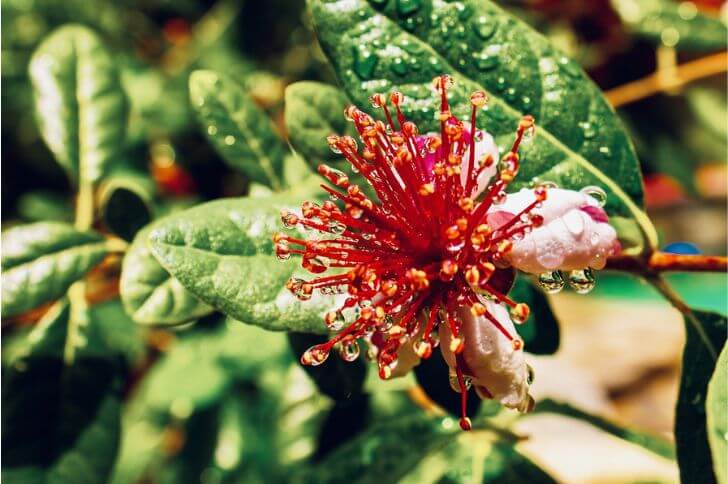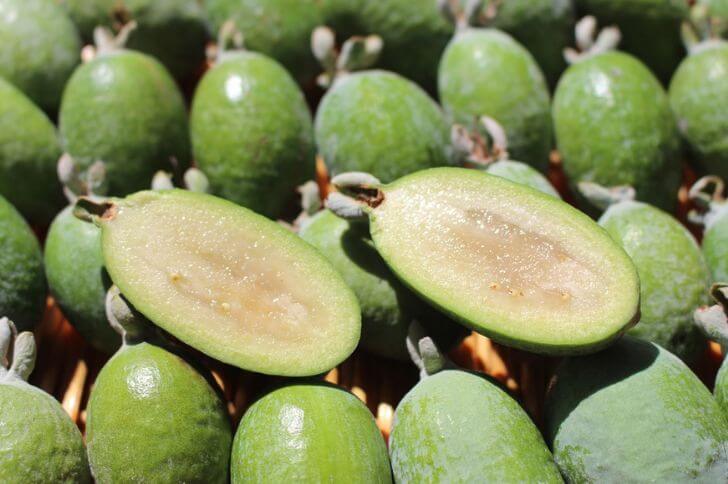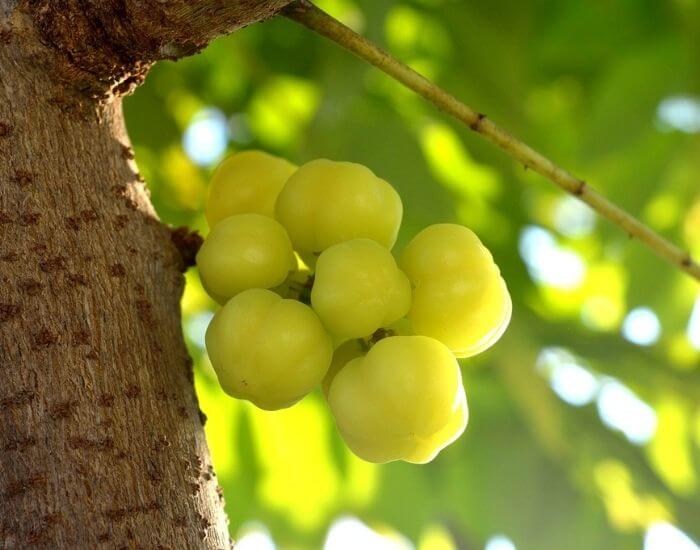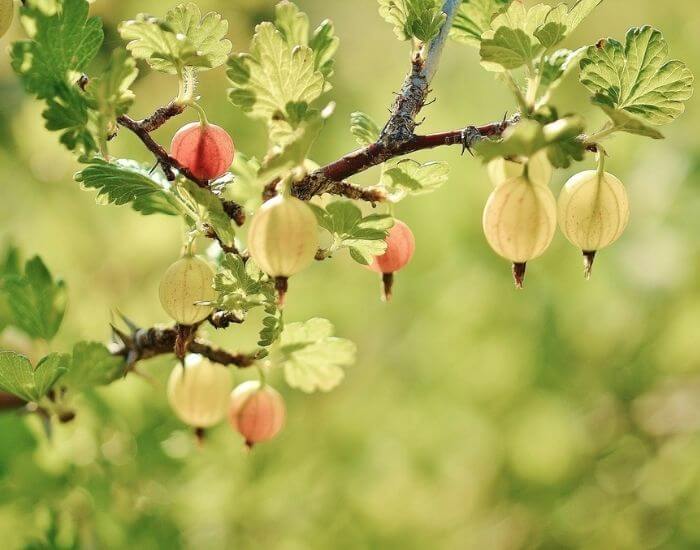Pineapple guava fruit is a common fruit in Australia, New Zealand, southern Brazil, Paraguay and parts of Argentina.
It is a fruit with many names. Depending on the region, this fruit may be known as feijoa, or guavasteen.
With its vibrant green skin, sweet-tart taste, and aromatic flesh, this exotic fruit has captivated taste buds around the world. Join us as we delve into the fascinating world of pineapple guava fruit – exploring its origins, characteristics, culinary uses, and the myriad of reasons why you should consider adding this exceptional fruit to your diet.
Pineapple guava varieties

When it comes to pineapple guava varieties, there are several different types that vary in taste, appearance, and size.
Kaiteri
Kaiteri is a popular variety of pineapple guava that is known for its exceptional taste and unique characteristics. One of the distinguishing features of Kaiteri is its larger size compared to other feijoa varieties.
Also this variety fruits early compared to other varieties on this list.
Kakariki
Also an early cropper. Appears at least a month before other varieties such as unique.
Anatoki
The anatoki variety matures at the same time as the kaiteri variety. Its large green plant produces large round fruits.
Bambina
Bambina is prized for its small size and sweet taste. It’s often referred to as the “baby pineapple guava” due to its diminutive stature.
Despite its small size, Bambina packs a punch when it comes to flavor. Its flesh is juicy and aromatic with a delightful sweetness that lingers on the palate.
Triumph
Triumph is one of the most common guavasteen varieties in New Zealand. It boasts of a sharp flavor compared to other varieties.
Unique
This guava variety is among the last to fruit, producing fruits from an early stage. Also note, it produces more fruits compared to varieties such as tagan II
Other pineapple guava varieties include tagan I & II, opal star, smith, trask, Apoll, Andre, coolidge, David, Edenvale late, Edenvale supreme, hehre, kakap, and gemini.
Cultivation
The pineapple guava fruit originates from South America. It is native to the highlands of southern Brazil, Uruguay, and northern Argentina. The plant was named after João da Silva Feijó, a Portuguese botanist who discovered it in 1815.
Pineapple guava plants were introduced to New Zealand in the 1900s and have since become a popular fruit there. In fact, New Zealand is now one of the largest producers and exporters of pineapple guavas in the world.
The climate in New Zealand’s North Island is particularly suitable for growing pineapple guavas due to its mild winters and warm summers.
In addition to South America and New Zealand, pineapple guava trees can also be found in other countries with similar climates such as Australia, California (USA), and Spain.
This versatile fruit has managed to adapt well to different regions around the world thanks to its hardy nature and ability to thrive in various soil types.
Feijoa color
How to tell if pineapple guava fruit is ripe? One way to determine if a guavasteen fruit is ripe is by gently squeezing it. It should have a slight give when you press it.
If the fruit feels hard or firm, it may need more time to ripen. Another helpful indicator of ripeness is the color of the skin. Ripe guavas generally have green skin with a yellowish tinge, while unripe ones tend to be entirely green.
Additionally, a ripe fruit will emit a pleasant aroma.
When is pineapple guava in season
In New Zealand, where pineapple guavas are extremely popular, the season runs from March to June. This is when you can find an abundant supply of fresh fruits at local markets and grocery stores.
In California, be on the lookout from late September through December and if you live in Florida, feijoas are available in August through November.
Ways to eat pineapple guava
One way you can eat a pineapple guava fruit is by cutting it in half and using a spoon to eat the soft flesh.
The creamy white flesh has a sweet flavor similar to that of pineapple and strawberry.
Another option is to slice the pineapple guava fruit into thin pieces and add them to salads for an extra burst of flavor.
Additionally, guavasteens can be used in baking recipes such as cakes, breads, muffins, or even jams and jellies. Its unique taste adds an interesting twist to traditional recipes while providing natural sweetness without being overpowering. With so many options available, there’s no shortage of ways to enjoy this delightful tropical fruit!
Feijoa cake
Ingredients:
-2 cups flour
– 1 teaspoon baking powder
– 1/2 teaspoon baking soda
– 1/4 teaspoon salt
– 1/2 cup unsalted butter, softened
– 3/4 cup sugar
– 2 eggs
– 1 teaspoon vanilla extract
– 1 cup mashed feijoas (about 6 feijoas)
– 1/2 cup plain yogurt
Instructions:
1. Preheat the oven to 350°F (175°C). Grease and flour a cake pan.
2. Combine dry ingredients
3. In a separate large bowl, cream together the butter and sugar until light and fluffy.
4. Mix eggs and vanilla
5. Mix in the mashed feijoas and yogurt until well combined.
6. Mix ingredients
7. Pour batter into the prepared cake pan and smooth the top.
8. Bake for about 40-45 minutes or until a toothpick inserted into the center comes out clean.
9. Cool for 10 mins.
10. Serve and enjoy!
Jam recipe
Ingredients:
-1 kg feijoas
– 500g sugar
– Juice of 1 lemon
Instructions:
1. Wash and peel feijoas, then cut into small pieces.
2. In a large pot, combine feijoas, sugar, and lemon juice.
3. Cook on medium heat until the mixture reaches a rolling boil.
4. Reduce heat to low and simmer for about 30 minutes, stirring occasionally.
5. Remove from heat and let cool before transferring to sterilized jars.
6. Seal jars tightly and store in a cool place. Enjoy your feijoa jam!
Feijoa drinks
One delightful way to drink pineapple guava is by making juice. To make this refreshing beverage, simply peel and blend the guavasteens until smooth.
Strain the mixture to remove any pulp or seeds, and then add some sugar or honey for sweetness if desired. Serve chilled over ice for a thirst-quenching treat.
Another creative way to enjoy pineapple guavas is by making smoothies. Blend the peeled and chopped fruit with yogurt or your favorite dairy-free alternative. You can also add other fruits like berries for added flavor and nutritional value.
For an extra twist, try adding a handful of fresh mint leaves or a squeeze of lime juice to enhance the taste of your pineapple guava smoothie.
In addition to juice and smoothies, there are endless possibilities when it comes to incorporating pineapple guava into drinks. You could infuse vodka or gin with pineapple guavas for a flavorful twist on classic cocktails like martinis or mojitos.
Alternatively, you can muddle pineapple guavas with herbs like basil or rosemary to create unique mocktails bursting with freshness and aroma. The options are limitless when it comes to enjoying the deliciousness of feijoas in liquid form!
Taste

What does a pineapple guava fruit taste like? It has a sweet flavor similar to pineapple, with hints of strawberry and apples. Some people also detect notes of mint or eucalyptus in its taste, adding to its refreshing and exotic quality.
The texture of pineapple guava is another interesting aspect. When ripe, the fruit has a slightly grainy texture similar to that of a pear. Its flesh is juicy, making it enjoyable to eat on its own or use in various culinary creations.
Overall, the taste experience of pineapple guava is often described as complex and delightful.
Nutrition Value
These guavas are low in calories and fat. A medium-sized pineapple guava contains about 40-45 calories and less than 1 gram of fat.
In addition to being low in calories, feijoas are also packed with essential nutrients. They are packed with vitamin C.
Furthermore, pineapple guavas contain several minerals that offer numerous benefits. They are a good source of potassium and magnesium.
Related: Learn about the exotic jaboticaba fruit
How to store
The best way to store pineapple guavas is by placing them in the refrigerator. Before storing, make sure they are ripe but not overripe. Wash and dry them to remove any dirt or debris.
Then, place in a plastic bag or an airtight container and store.
Alternatively, if you have an abundance of feijoas and want to preserve their flavor for future use, freezing is another great option.
Where to buy
If you live in California and Florida, certain stores may have these fruits during peak season. These fruits are usually sold individually or in packs and can be found in the produce section alongside other tropical fruits.
Another option for getting pineapple guava fruit is to visit a farmers market or specialty food store.
Additionally, if you live in a place where this tree thrives and have access to a garden or outdoor space, you could consider growing your own fruits.
Pineapple guava trees thrive in warm climates with mild winters and can be purchased from nurseries or online plant retailers.
Is feijoa fruit same as kiwi fruit?
One of the main differences between pineapple guava and kiwi is their taste. While kiwi has a sweet and tangy flavor with a hint of tartness, pineapple guava offers a more complex taste profile.
Pineapple guavas have a distinct combination of flavors that can be described as a mix of pineapple, guava, and strawberry with floral undertones.
Another notable difference between these two fruits lies in their texture. Kiwis have a soft and juicy flesh with small black seeds distributed throughout the fruit. On the other hand, pineapple guavas have a slightly grainy texture and contain larger edible seeds in the center.
Is pineapple guava like guava?
Pineapple guava is often mistaken for the common guava fruit due to their similar appearance. However, despite their resemblance, pineapple guava and guava are two distinct fruits with different taste profiles and nutritional compositions.
Pineapple guava has a unique flavor that can be described as a combination of pineapple, strawberry, and mint. Its aromatic flesh is sweet, making it an excellent addition to desserts, jams, and beverages.
On the other hand, guava has a more tropical taste with notes of papaya and passionfruit. It is commonly enjoyed fresh or juiced.
Can you eat the skin of a feijoa sellowiana
The answer is yes, you can eat the skin of a pineapple guava! In fact, the skin is completely edible and contains numerous benefits.
The skin of a pineapple guava is thin in texture. It has a tart taste that complements the sweet and tangy flesh inside.
Final Thoughts
Feijoa is a unique and delicious fruit that offers a range of benefits. Whether you enjoy it fresh or incorporate it into your favorite recipes, this tropical gem is sure to impress your taste buds.
Head to your local grocery store or farmer’s market and experience the delightful flavors and numerous advantages of this wonderful fruit today!
source:
Hi There,
My name is Jenny. I’m the Chief Editor at Try Green Recipes and besides making yummy and healthy foods for my kids, grandkids, and friends. I’m new to the blogging world but I believe what I have to share is unique and will bring joy to your home. If you are adventurous and want try something tasty, let’s get started.

